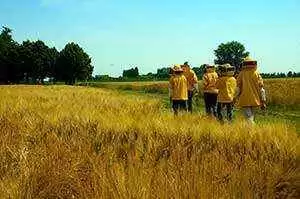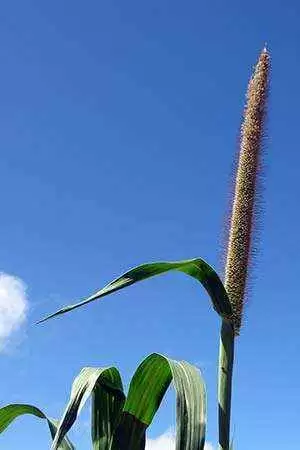
Celiac.com 03/19/2015 - Almost half of Americans eat no whole grains at all and those who do eat them only consume a single serving per day—far below the 3 to 5 daily servings recommended by the USDA. People often tell me, "I might eat more whole grains if I just knew which ones to choose and how to prepare them."
There are many wholesome, gluten-free grains that add flavor, variety, and texture to our diet and—if you read this article—you'll know which ones to choose and you'll learn some easy ways to prepare them at home.
Celiac.com Sponsor (A12):
A Quick Definition of Whole Grain
What is a whole grain? Scientists use technical explanations, but to me it means the WHOLE grain or seed with everything intact and nothing removed. A whole grain contains the outside layer of bran and fiber, the middle layer or germ which contains important nutrients such as B-vitamins, and the inner part called the endosperm which provides energy and carbohydrates.
Many whole grains are also naturally gluten-free, including amaranth, brown rice (but not white rice because the outer layers are milled away), buckwheat, hominy, millet, quinoa, sorghum, and teff. These grains are generally available at your natural food store. Some of these grains—such as buckwheat—are actually seeds of fruit but we treat them as grains in cooking. Gluten-free whole oats (or oat groats as they're typically called) are whole grain and are available from Open Original Shared Link and Open Original Shared Link. Be sure to check with your physician to see if these gluten-free oats are right for you.
Whole Grains for Breakfast
When we think of grains, we think of cereal. And, when we think of cereal, we automatically think of breakfast, so let's start there. Whole grains make terrific hot cereal, but they take a while to cook and most people don't have that much time in the morning.
Of course, you can always cook whole grains the traditional way on the stovetop the night before, if you have time. In my latest book, Gluten-Free Quick & Easy, I encourage ways to more easily incorporate whole grains into our diets with minimal time investment. This is the perfect opportunity to pull that slow cooker out from the back shelf of your pantry or to invest in a pressure cooker. The slow cooker cooks the whole grains overnight or the pressure cooker does it quickly the night before.
Slow Cooker Grains. Put 1 cup of any of the whole grains mentioned above, 3 ½ to 4 cups water, and ¼ teaspoon salt in a slow cooker. Cook on low all night and the next morning you have hot, cooked whole grains for breakfast. The grains will have softened and resemble porridge because they absorbed lots of water.
Pressure Cooker Grains. Be sure to follow your pressure cooker's directions. Lorna Sass, in her James Beard award-winning cookbook, Whole Grains: Every Day, Every Way, suggests using 4 cups water, 1 tablespoon vegetable oil, and ½ teaspoon salt for each 1 cup of whole grain. Brown rice can be ready in 15 minutes while gluten-free oat groats take 30 minutes, but these times are significantly shorter than traditional cooking times. You can cook the grains while you're preparing dinner or after the dinner dishes are done. Drain any extra water from the grains and refrigerate the cooked grains before you go to bed. Unlike the slow cooker method, which produces a more porridge-like consistency, whole grains cooked in a pressure cooker more closely resemble their original shape. Cooked whole grains keep refrigerated for about a week. I simply reheat the refrigerated cooked grains in the microwave oven.
Regardless of whether I cook the grains in a slow cooker or pressure cooker, I like to mix them with honey, agave nectar, brown rice syrup, chopped nuts, or brown sugar and a sprinkle of cinnamon and flax meal for a marvelous breakfast that is packed with fiber and nutrients.
If you would like to make your own breakfast porridge with the sweeteners and fruit cooked in it, try my easy Slow Cooker Brown Rice Porridge recipe (page 12).
Whole Grains as Side Dishes
Whole grains such as brown rice, buckwheat, millet, quinoa, and sorghum stand in nicely for savory side dishes made from rice, couscous, wheatberries, and bulgur. And, the new gluten-free whole oat groats make nice side dishes as well. You will find an excellent Toasted Oat Pilaf recipe at Open Original Shared Link that demonstrates how to use the new gluten-free steel-cut oats as a savory dish.
The basic idea is to add herbs and seasonings to the cooked whole grains in the same way and in the same amounts as you would add them to cooked rice, couscous, wheatberries, or bulgur. Any recipe that uses these grains can be adapted to use your favorite gluten-free whole grains.
Want to Learn More about Whole Grains?
If you would like to know more about the whole grain stamp used on store-bought foods, go to Open Original Shared Link. Or, if you want to learn more about nutritional content of gluten-free grains, see Gluten-Free Diet: a Comprehensive Resource Guide by Shelley Case, RD, (Expanded Edition, Case Nutrition Consulting, 2006). To learn more about cooking whole grains using a variety of methods, see Whole Grains: Every Day, Every Way, by Lorna Sass (Clarkson Potter, 2006). Not all of the grains are gluten-free, but the cooking instructions and innovative preparation techniques for the gluten-free grains are very helpful.









Recommended Comments
Create an account or sign in to comment
You need to be a member in order to leave a comment
Create an account
Sign up for a new account in our community. It's easy!
Register a new accountSign in
Already have an account? Sign in here.
Sign In Now